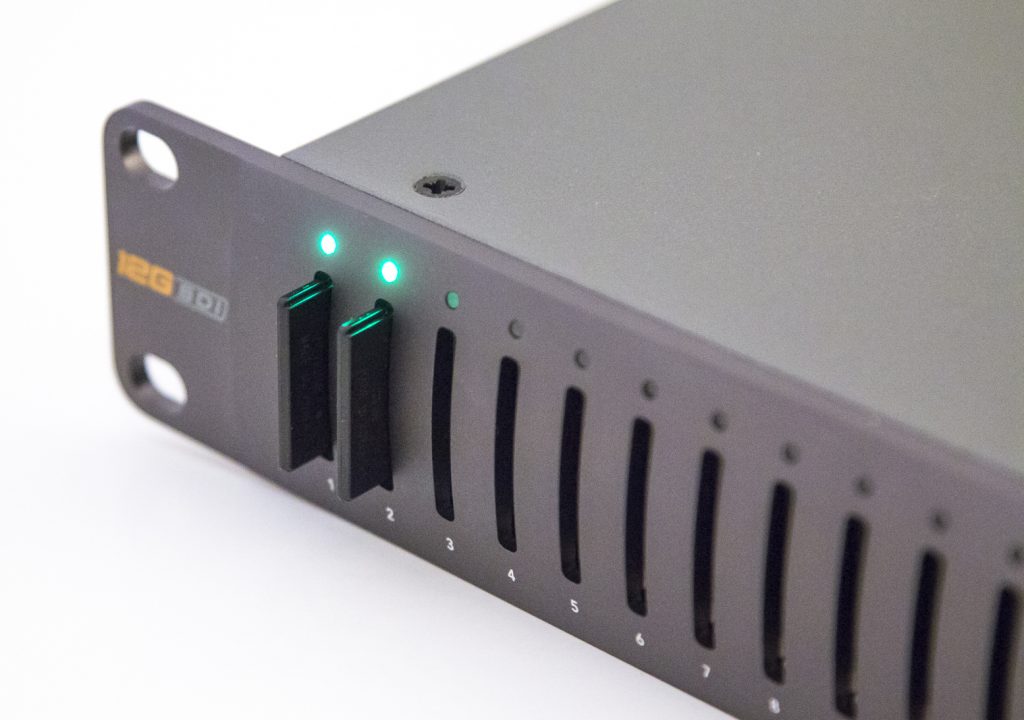Learning how to use the Duplicator 4K is so easy it can be taught to an eight-year-old child via text message. The tech, at least the user interface, is that easy to master. This is the big bonus found in Blackmagic’s Duplicator 4K, which would be great if there was not an obvious negative counterbalancing the positive. In time, this negative will transform into a positive. Then, and only then, we will see Blackmagic’s Duplicator 4K become the necessary accessory to nearly all ATEM switchers out in the hands of production companies worldwide.
Super Simple
It feels rare these days to face a brand spanking new piece of gear which is also easy to operate. What I write next is meant with absolutely zero snarkiness or joking: Any adult should be able to learn how to use the Duplicator 4K in a less than a minute or two. I think Blackmagic nailed this part of the Duplicator 4K.
Of course, you can make the actual recording process even more simplified. You can set the Duplicator 4K to use an SDI trigger or Time Code “TC” run trigger. This means the Duplicator 4K will begin recording if either the Time Code starts to run or if “record” is pressed on the SDI device feeding into the Duplicator 4K. Again, it is very easy to understand and put into action.
Even the daisy chaining of multiple Duplicators 4K together is easy to understand. The top, or first duplicator, acts as a remote to the duplicator below it and that one to the one below it… etc. Each Duplicator slaves the Duplicator below which is all led by the topmost Duplicator. Okay, writing that out makes it sound a little less easy to operate, but trust me it is easy. One can understand the process from Blackmagic’s picture directions that come with the kit.
What’s Not Easy
The Duplicator 4K records to an H.265 codec. There is nothing inherently wrong with the H.265 codec. It is a great codec for squeezing large 4K files into small spaces. I have DaVinci Resolve and the program has zero problems playing the H.265 codec, but I doubt customers who may benefit from a recorded live event, like a wedding or concert, will have anything close to DaVinci Resolve on their computers. Production company’s who choose to hand off SD Cards recorded via the Duplicator 4K likely will have to send a set of viewing instructions along with the SD Cards. This is a case of Blackmagic ending up a little bit too far ahead of most people’s tech. What is needed is for QuickTime and other basic video players to be able to smoothly play H.265 videos. Then the Duplicator 4K is a strong asset for many. Until then, I think the Duplicator 4K would benefit with an H.264 option for HD recording only.
exFAT Formatting Only
This might feel like Blackmagic left off a Mac OS choice when formatting cards, but I feel this was an intentional decision. Having only exFAT as an option means the SD Cards can be played on any computer. If there was a Mac OS option then PC users could be left out from viewing a video. This is a potential headache for producers and production companies. I could not imagine the phone calls and emails from angry customers. Consider this single option as a way to stop you from making a bad decision.
The Footage
Blackmagic boasts the Duplicator 4K can record three different bit rates: Low, Medium, and High. I did a little testing with my URSA Mini 4.6K, the Duplicator, and the Video Assist 4K. I set up a very simple scene in my dining room and ran through the three options. I can say, in my very non-scientific testing, there did not seem to be much of a difference in the three different bit rates. I bet if the visuals of a scene, like a live concert, pushed the capabilities of a camera’s sensor then the differences between the Low, Medium, and High bit rates would be more apparent.
Who Will Use The Duplicator 4K?
I think anyone who owns an ATEM switcher might want to think about picking up a Duplicator 4K. The ability to record events live to SD cards you’re going to hand off or sell is a neat party trick. This is exactly how Blackmagic showed off the Duplicator 4K at NAB 2016. They recorded their Press Conference live and handed all the attendees a small SD card as a parting gift. It’s as if they’re saying, “Now you can re-watch this in case you lost your notes.”
If the cost of SD Cards goes down then the Duplicator 4K could make for an excellent newsroom archive system. Many television stations rely on an Avid system, and its expensive shared storage, to archive their news shows. This is less than an ideal situation in my opinion. Assets can be deleted out of a shared storage system to be lost forever. A Duplicator 4K could record a whole days worth of news shows, from the morning show to the 11pm or 10pm, onto any number of cards giving a station many different copies to be stored in different places.
I also think any production company who works in the multi-cam event world could benefit from using the Duplicator 4K. Like I said before, it could be a very neat party trick to hand the Bride’s parents a copy of their daughter’s wedding ceremony almost immediately after the event. Instant gratification, and who does not love instant gratification.
Ultra HD Format Support
- 2160p23.98, 2160p24, 2160p25, 2160p29.97, 2160p30, 2160p50, 2160p59.94, 2160p60.
HD Format Support
- 720p50, 720p59.94, 720p60
- 1080p23.98, 1080p24, 1080p25, 1080p29.97, 1080p30, 1080p50, 1080p59.94, 1080p60,
- 1080PsF23.98, 1080PsF24, 1080PsF29.97, 1080PsF25
- 1080i50, 1080i60
SD Format Support
- 525i59.94 NTSC, 625i50 PAL

